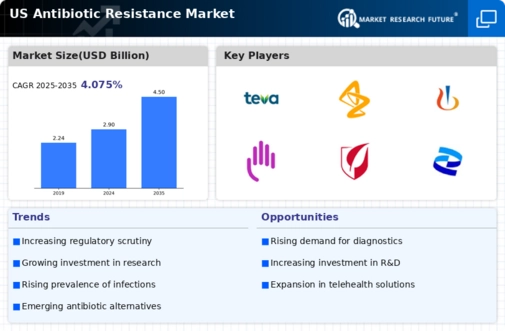Government Initiatives and Funding
Government initiatives aimed at combating antibiotic resistance play a pivotal role in shaping the antibiotic resistance market. The US government has allocated substantial funding to support research and development efforts, with the National Institutes of Health (NIH) and the Biomedical Advanced Research and Development Authority (BARDA) leading the charge. In 2025, federal funding for antibiotic resistance research is projected to exceed $1 billion, reflecting a commitment to addressing this public health crisis. These initiatives not only enhance the development of novel antibiotics but also promote collaboration between public and private sectors, thereby accelerating the pace of innovation within the antibiotic resistance market.
Surge in Antibiotic-Resistant Infections
The rising incidence of antibiotic-resistant infections in the US is a critical driver for the antibiotic resistance market. According to the Centers for Disease Control and Prevention (CDC), over 2.8 million antibiotic-resistant infections occur annually, leading to more than 35,000 deaths. This alarming trend necessitates the development of new antibiotics and alternative therapies, thereby propelling market growth. The increasing burden on healthcare systems due to prolonged hospital stays and higher treatment costs further emphasizes the urgency for innovative solutions. As healthcare providers and policymakers recognize the need for effective interventions, investments in the antibiotic resistance market are likely to increase, fostering advancements in research and development.
Technological Advancements in Diagnostics
Technological advancements in diagnostic tools are transforming the antibiotic resistance market by enabling rapid identification of resistant pathogens. Innovations such as next-generation sequencing and point-of-care testing facilitate timely and accurate diagnosis, allowing healthcare providers to tailor antibiotic therapies effectively. The market for diagnostic solutions is expected to grow at a CAGR of approximately 10% from 2025 to 2035, driven by the increasing demand for precision medicine. Enhanced diagnostic capabilities not only improve patient outcomes but also contribute to the prudent use of antibiotics, thereby mitigating the spread of resistance. As a result, the integration of advanced diagnostics into clinical practice is likely to bolster the antibiotic resistance market.
Increased Collaboration Among Stakeholders
Collaboration among various stakeholders, including pharmaceutical companies, academic institutions, and government agencies, is emerging as a vital driver for the antibiotic resistance market. Initiatives such as the Antimicrobial Resistance Challenge encourage partnerships to foster innovation and expedite the development of new antibiotics. By pooling resources and expertise, stakeholders can address the multifaceted challenges posed by antibiotic resistance more effectively. This collaborative approach not only enhances research and development efforts but also facilitates the sharing of best practices and data. As the urgency to combat antibiotic resistance intensifies, such collaborations are likely to play a crucial role in shaping the future landscape of the antibiotic resistance market.
Rising Healthcare Costs and Economic Burden
The economic burden associated with antibiotic resistance is a significant driver for the market. The CDC estimates that antibiotic-resistant infections cost the US healthcare system approximately $20 billion annually in direct medical costs, with an additional $35 billion in lost productivity. This financial strain underscores the necessity for effective interventions and novel therapies to combat resistance. As healthcare providers seek to reduce costs and improve patient outcomes, investments in the antibiotic resistance market are expected to rise. The potential for cost-effective solutions that can alleviate the economic impact of antibiotic resistance presents a compelling opportunity for stakeholders in the market.

















Leave a Comment